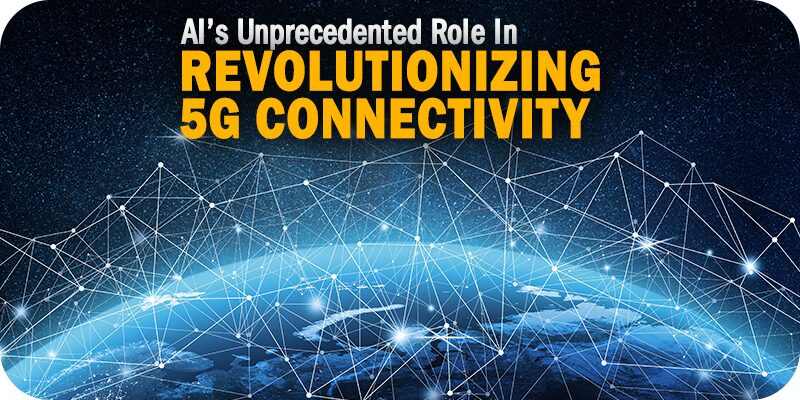AI’s Unprecedented Role in Revolutionizing 5G Connectivity


Solutions Review’s Contributed Content Series is a collection of contributed articles written by thought leaders in enterprise software categories. Manish Mangal of Tech Mahindra dives into detail AI’s unprecedented role in revolutionizing 5G connectivity.
The development and standardization of 5G connectivity has been a long time coming. The groundwork for 5G started before 2015, when companies and researchers were exploring new technologies that could improve upon 4G and LTE. Little did they know that by the time 5G was ready for commercial rollout, artificial intelligence (AI) would be available to help ensure successful deployment and operation of the network.
The convergence of AI and 5G networks has ushered in a new era of possibilities for the telecom industry. By combining the immense processing power of AI with the lightning-fast connectivity of 5G, operators can unlock a host of opportunities to optimize network performance, streamline operations, and pioneer innovative services. As the technology matures, its impact on the telecom industry is likely to be even greater.
5G Connectivity and the Role of AI
Intelligent Network Planning
AI plays a pivotal role in network management, particularly in the context of modern and complex 5G networks. AI-powered systems can monitor network health, detect anomalies, and proactively address issues. AI can also be instrumental in network planning, helping operators make informed decisions about infrastructure and capacity requirements. By analyzing historical data and predicting future demand, AI algorithms optimize network planning while reducing costs.
AI algorithms analyze data from various sources, such as geographical information systems (GIS) and customer demand patterns, to determine the best placement of network equipment and efficient deployment strategies. This speeds up network deployment, minimizes errors, and optimizes resource utilization.
Cognitive & Secure Network Operations
AI enhances the security of 5G networks, enabling the telecom industry to protect data and combat threats. AI algorithms can detect and mitigate security breaches by identifying anomalous behaviors and patterns of malicious activities in real-time. This proactive approach helps safeguard sensitive information, maintain user privacy, and preserve network integrity.
AI facilitates predictive security analytics, empowering operators to anticipate vulnerabilities and strengthen network defenses. By analyzing data and identifying potential risks, AI-driven security systems enable the telecom industry to stay ahead of cyber-criminals, ensuring trust and confidence from customers and businesses.
Energy Management
The growing demand for data and connectivity raises concerns about energy consumption in the telecom sector. Integrating AI into 5G networks offers innovative solutions for energy efficiency, empowering operators to optimize power usage, reduce their carbon footprint, and enhance sustainability.
AI algorithms analyze real-time data from network components like base stations, switches, and routers to identify energy inefficiencies and optimize power use. They dynamically adjust power levels based on traffic patterns, minimizing unnecessary energy consumption during low-activity periods. AI also optimizes network operations to reduce energy use while maintaining service quality. For example, AI algorithms can predict network traffic and then adjust data transmission routing to save energy and improve overall network efficiency.
AI is pivotal in integrating renewable energy into 5G networks. By analyzing weather patterns and energy forecasts, operators can optimize the use of renewable sources like solar panels and wind turbines. AI-driven energy management systems prioritize renewable energy, reducing reliance on non-renewable sources and lowering the industry’s carbon footprint. The benefits of AI-powered energy management extend beyond cost savings and environmental sustainability. By efficiently managing energy consumption, operators can ensure uninterrupted network services during power outages or emergencies. It maximizes network uptime, prioritizes critical elements, reroutes traffic, and allocates power resources efficiently, improving user experiences.
Optimize Network Performance
The integration of AI into 5G networks brings significant advancements in network performance. AI algorithms can analyze network traffic, predict demand fluctuations, and allocate resources effectively. This results in improved network utilization, reduced latency, and increased bandwidth availability. These enhancements enable the telecom industry to offer superior user experiences, such as seamless video streaming, immersive virtual reality, and responsive gaming on mobile devices. AI also helps optimize network coverage through intelligent beamforming and antenna configurations. By adapting to user needs, AI ensures high-quality signals, even in crowded areas. This optimization opens the door to innovative services like smart cities, autonomous transportation, and remote industrial applications. This creates new revenue streams for the industry.
Empowering Edge Computing
Combining AI with 5G networks opens up new opportunities for edge computing. AI algorithms at the network’s edge enable instant data analysis, reducing delays and improving efficiency— this benefits applications like autonomous vehicles, remote healthcare, and smart infrastructure that require low latency. The telecom industry can utilize this collaboration to provide real-time insights and rapid responses. For instance, AI-powered edge computing transforms healthcare with remote diagnostics, reducing emergency response times. Local data processing at the edge eases the load on centralized cloud systems, resulting in cost savings and better network performance.
Clearly, the convergence of AI and 5G networks presents significant potential for the telecom sector to transform its operations and services. By embracing AI-driven technologies, telecom providers can lead the industry, drive innovation, generate new revenue streams, and offer unparalleled user experiences. To harness this potential, telecom operators need to invest in infrastructure, collaborate with AI experts, and foster an innovative culture. These efforts will enable them to leverage the synergy between AI and 5G networks, creating a more connected, efficient, and innovative future.



















